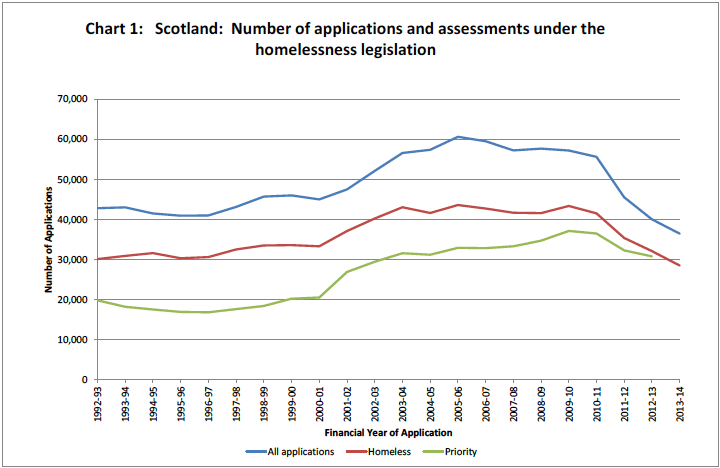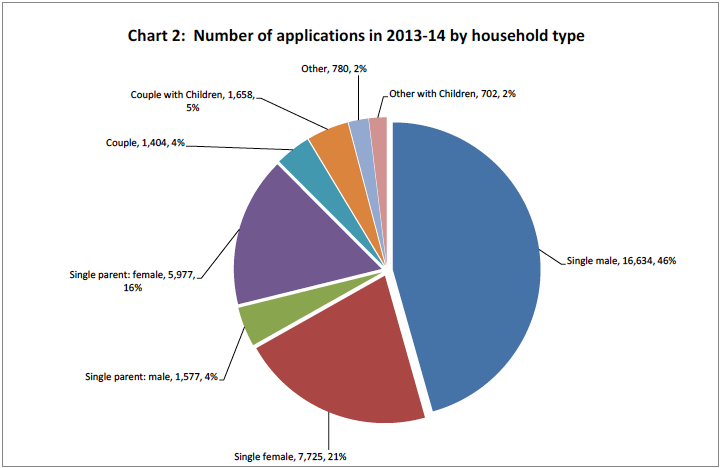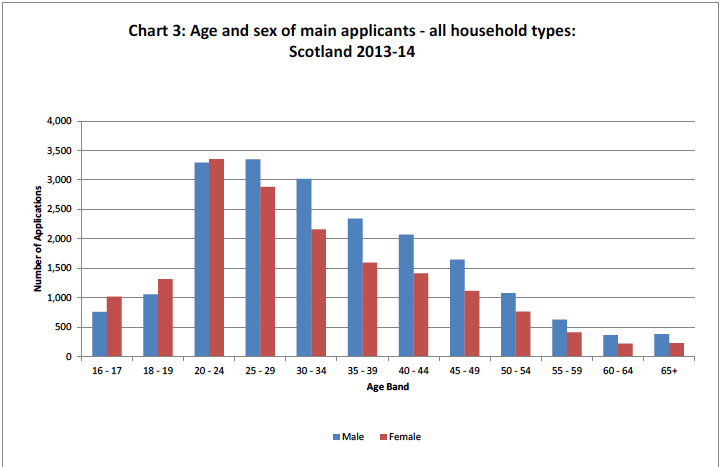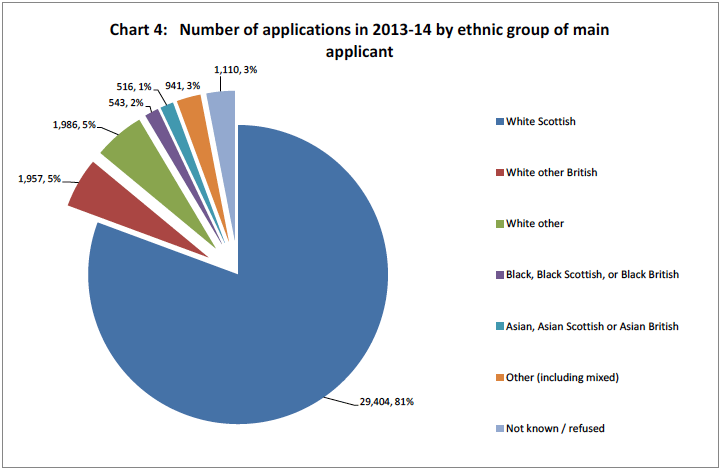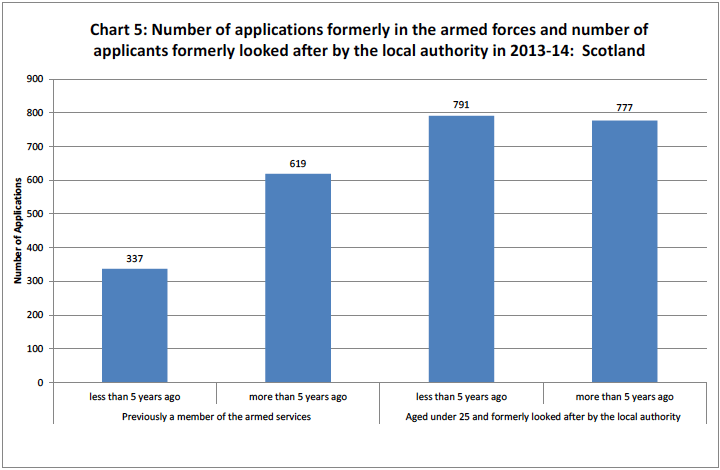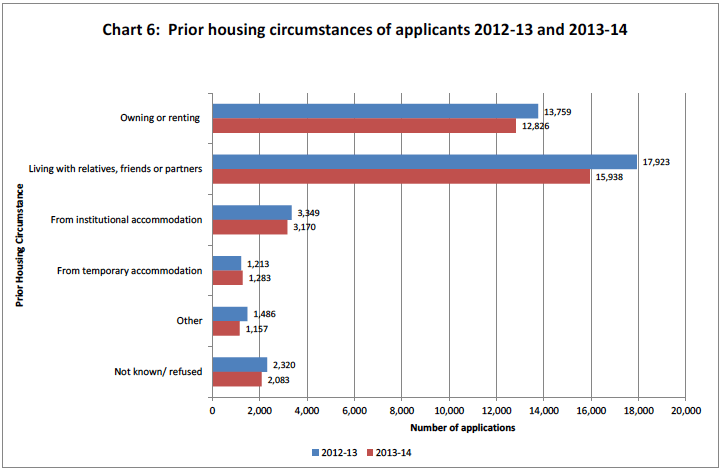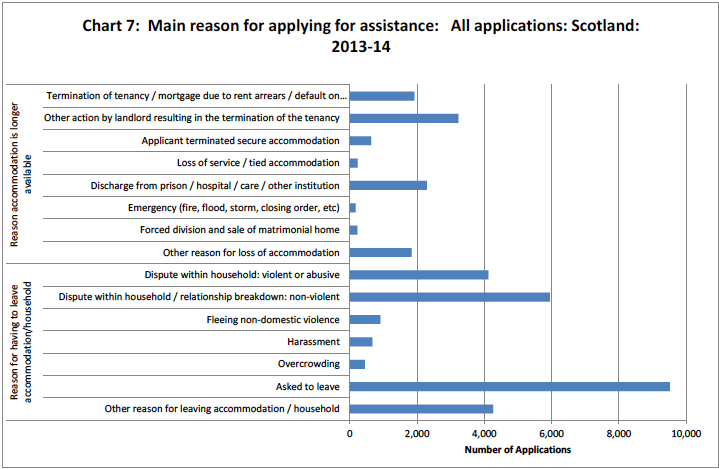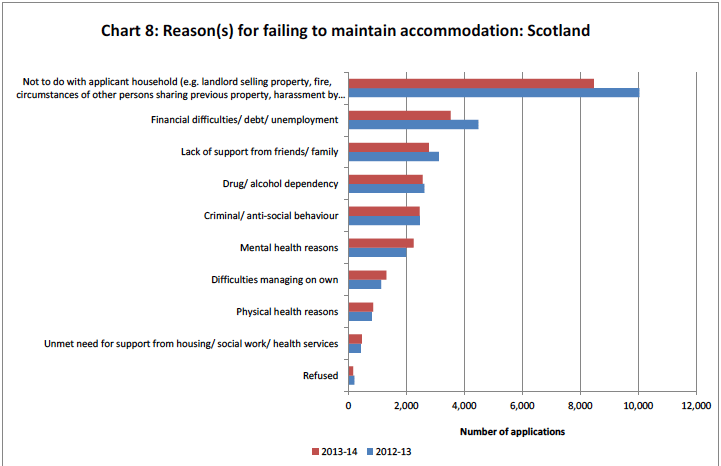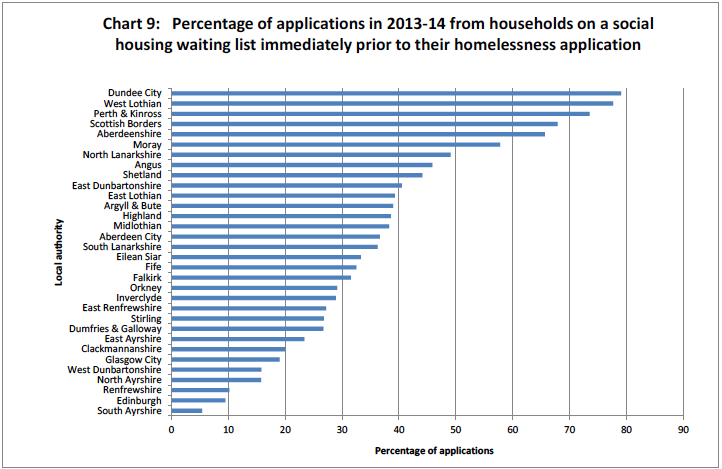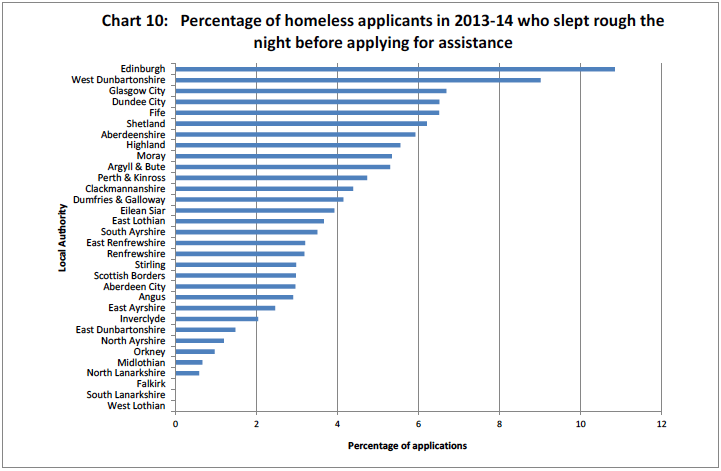Operation of the Homeless Persons Legislation in Scotland: 2013-14
This bulletin provides information on homelessness applications, assessments and outcomes to 31 March 2014. It includes information on the characteristics of applicant households, local authority assessments and the action taken in respect of cases that were concluded. Snapshot data on households in temporary accommodation at 31 March 2014 are also presented.
3. Applications (Table 1 to Table 5e and Chart 1 to Chart 10)
Trends
3.1. Chart 1 shows the number of homeless applications, the number of these assessed as homeless and the number of priority assessments in each year between 1992-93 and 2013-14. Changes in applications and assessments over this period have in part been driven by changes in legislation, policy and practice.
3.2. The increase in homelessness between 2000-01 and 2006-07 was, in part, a consequence of Scottish homelessness legislation [1] which extended councils' duties to non-priority homeless households.
3.3. The narrowing of the gap between the number of homeless and the number of priority homeless from 2000-01 is primarily a consequence of action by local authorities to move towards the 2012 homelessness commitment - that by December 2012 all homeless households will be assessed as being in priority need. Section 4 below provides more detail.
3.4. The reduction in homeless applications from 2006-07 and in particular the very large continuing reductions from 2010-11 are mainly due to the impact of the introduction of housing options services in Scottish local authorities with a focus on prevention.
Note: In November 2012 the Scottish Parliament approved the Homelessness (Abolition of Priority Need Test) (Scotland) Order 2012. With the priority need test now abolished, information on this aspect of the homelessness legislation is no longer collected.
Recent changes
3.5. Between 1 April 2013 and 31 March 2014 councils received a total of 36,457 homelessness applications (Table 1). This is a reduction of over 3,593 (8%) applications over the previous year.
3.6. The number of applications in 2013-14 is 40% lower than the peak value seen in 2005-06, when around 61,000 homelessness applications were made (Chart 1).
3.7. During 2013-14 the number of applications has fallen in 24 out of 32 local authorities (Table 1b). In fifteen councils the number of applications fell by up to 10% and in two councils - East Ayrshire and Midlothian - the number of applications fell by over 20%. Applications have increased in eight local authority areas - East Renfrewshire (25% increase), East Dunbartonshire (18% increase), North Ayrshire (13% increase), Scottish Borders (6% increase), and four authorities with increases of 1% or less.
What is causing the reductions?
3.8. It is very unlikely that the large reduction in homelessness applications over the past two years is a consequence of any changes in the social and economic factors which cause households to approach councils for assistance with an acute or urgent housing need. Quite the contrary, all other things being equal, we might have expected homeless applications to increase in the current economic environment and also as a consequence of Welfare Reforms.
3.9. It is much more likely that the reductions are a consequence of a major Scotland wide approach to prevent homelessness. Through this, councils have been developing services, generally described as 'housing options services' in which staff assist households to consider the range of options available to address their housing needs. For example councils might provide mediation services to assist in resolving disputes within the household, or they might assist households secure a private let by guaranteeing the rent deposit. As a consequence, some of the households who might previously have made a homelessness application will now have their housing needs met without first becoming homeless or being threatened with homelessness [2].
3.10. An Evaluation of the homelessness options hubs published in May 2012 showed that there was wide variation between councils in the speed of implementation of housing options/ homelessness prevention. The evaluation stated that it was not possible within the evaluation methodology to attribute all of the reduction in applications to the impact of the housing options approach. (Paragraph 2.14). The evaluation also notes in paragraph 3.30 that "[a number of local authorities] felt that the progress on housing options 'on the ground' has been very significant indeed". The evaluation, which only covered the start of the roll out of the approach, also went on to add that "a smaller number of local authorities are not in a position yet to have started to make progress."
3.11. The Scottish Housing Regulator published its thematic inquiry into housing options in Scotland in May 2014. The report summarised its findings by saying "Housing Options is a recent development and to date there has been no comprehensive evaluation of the policy. The limitations in guidance and the absence of a comprehensive monitoring framework are important factors in considering how Housing Options has been implemented so far. The introduction of mandatory data collection for local authorities provides a basis for a national evaluation of the policy."
Impact on Applications and Assessments
3.12. Housing options appears to be having a uniform impact across household types and age groups, at least at the Scotland level. Based on analysis of the HL1 homelessness data, there is no evidence to indicate that any one group is being impacted more by housing options work than any other.
3.13. However, whilst the number of applications has reduced, how these applications are assessed appears to be changing slightly. In 2009/10 and 2010/11, approximately 75% of cases were assessed as homeless or potentially homeless. However, by 2013/14, this proportion had increased by about six percentage points to 81%. The main reason for this change is a decrease in cases where contact was lost prior to the assessment decision being made. (Table 1c and Table 1d).
3.14. In summary, whilst housing options work is reducing the total number of applications overall, the evidence suggests that it is also reducing the number of lost contacts between the application and assessment stage.
Characteristics of applicants
3.15. Of the 36,457 applications for assistance in 2013-14, around 24,400 (67%) were single people, of whom around 16,600 were men and 7,700 were women (Table 2). Around 9,200 applications (25% of applications) were from households with children, most of whom were single parent households (21% of all applications). Of the 7,554 applications by single parents, 5,977 (79%) were by female applicants. (Chart 2)
3.16. Overall, whilst the number of applications has changed over the last ten years, the profile of households has changed only slightly. The proportion of single parents has remained in the range 21% to 24% since 2002-03: the figure for 2013-14 was 21%. However, since 2007-08, there has been a small but noticeable increase in applications from single people, increasing at a rate of around one percentage point per annum, from 60% in 2007-08 to 67% in 2013-14. (Chart 2 and Table 2c).
3.17. Chart 3 shows the age distribution of the main applicant in the household, for those who applied as homeless in 2013-14. Homeless households have a young age profile - around half are headed by someone aged under 30 (47% in 2013-14). Female applicants typically have a slighter younger age profile than males - 35% of female applicants are aged under 25 while this figure is only 26% for male applicants.
3.18. The proportion of homeless applications by ethnic group has remained unchanged since 2007-08. During 2013-14, in 91.5% of applications the main applicant was recorded as White, 1.5% were recorded as Black, Black Scottish or Black British, 1.4% were recorded as Asian, Asian Scottish or Asian British and 2.6% as in other ethnic groups (Chart 4). An ethnic group was not recorded for 3.0% of all applicants.
3.19. Table C shows the number of homelessness applications, and assessments according to the categorisations in the 2011 census data The lowest proportion of homeless applications is from the Asian, Asian Scottish or Asian British category (37 per 10,000 population), the highest proportion from a known category is from the Caribbean or Black category (196 per 10,000 population), there were 852 applications from another, but unspecified ethnic groups (595 per 10,000 population). Polish homelessness applications accounted for 82 applications per 10,000 population.
3.20. In 2013-14, 366 applicants were recorded by local authorities as being a gypsy / traveller at the time of application (869 per 10,000 population). However, there is a disconnect between applicants being recorded as gypsy/ travellers in the homelessness data and applicants citing their ethnicity as gypsy/ travellers. For example, of the 366 applicants in the homelessness data, 74% gave their ethnicity as White: Scottish, and only 5% gave their ethnicity as White: Gypsy / Traveller. No response was given to the gypsy / traveller question for 706 applicants in 2013-14.
3.21. In 2013-14, 956 homeless applicants had a household member who had previously been in the armed forces - the lowest number recorded to date. Of these, 337 had been in the armed forces less than 5 years ago and 619 more than 5 years ago. (Chart 5) It should be noted that, for 1,442 applications, the response to the question asking about service in the armed forces was 'not known/ refused'.
3.22. In the same period, 1,568 applicants aged under 25 had a household member who had been formerly looked after by the local authority, of whom 791 had been looked after within five years of making their homelessness application. (Chart 5). This was the lowest number of applications received from formerly looked-after people since recording began in 2007-08. It should be noted that for 1,019 applications, 'not known/ refused' was the response when asked if a member of the applicant household had been previously looked after by the local authority.
Prior circumstances of applicants
3.23. Of the 36,457 homelessness applications in 2013-14, 15,938 (44%) had been living with friends and relatives, while 12,826 (35%) had been living in their own accommodation (i.e. which they either rented or owned). (Table 3 and Chart 6).
Reasons for homelessness
3.24. The main reasons for applying as homeless have remained unchanged over the past year. Relationship breakdown is the main cause of homelessness applications. This is reflected in the high numbers of applicants who cite a dispute within the household (27% of all applications in 2013-14) or being asked to leave (26% of 2013-14 applications). (Table 4 and Chart 7). Rent arrears or mortgage default account for around 5% of all homelessness applications in 2013-14, while 6% of applications are from those leaving prison/ hospital/ care or some other institution.
3.25. In addition to the main reason for homelessness, the homelessness statistical return (HL1) allows applicants to identify factors which have also contributed to their homelessness. This reflects the fact that the causes of homelessness can be complex and not the result of a single incident or event. In 2013-14 additional contributory reasons were recorded for 50% of applications. (Tables 5d and 5e).
3.26. Of those cases where there was an additional factor contributing to homelessness. Chart 8 shows that:-
- In 8,468 cases (47% of those providing additional reasons, down from 49% in 2012-13) it was 'not to do with the applicant household'. This includes reasons such as the landlord selling the property, fire, circumstances of other persons sharing the property or harassment by others.
- In 3,528 (21%) of these cases 'financial difficulties, debt or unemployment' was an additional factor.
- In 2,784 (15%) of these cases lack of support from friends and family was an additional factor.
- In 2,566 (14%) of these cases drug or alcohol dependency was an additional factor.
- Also in 2,462 (14%) of cases criminal or anti-social behaviour was a factor.
Financial and economic reasons for homelessness applications
3.27. There was a 17% reduction between 2012-13 and 2013-14 in the number presenting as homeless because of rent arrears to a local authority (-48 homeless applications), an increase of 6% in the number presenting as homeless because of rent arrears to a housing association (+11 applications), and a reduction of 3% in the number presenting as homeless because of rent arrears to a private landlord (-23 applications) (Table 5a).
3.28. There was also a decrease of 58 applications (11%) in those presenting as homeless because of mortgage default, from 545 applications in 2012/13 to 487 applications in 2013/14 . (Table 5a).
3.29. The number presenting as homeless because of the forced division and sale of the matrimonial home dropped substantially from 725 in 2007-08, to 374 in 2008-09. Since then there have been around 340 applications per year due to forced divisions. During 2013-14, this reduced further to only 187 applications, a reduction of 7% on the previous year.
3.30. In 2013-14, there were 1,924 applications (5% of applications) which cited rent arrears or mortgage default as the main reason for the application (Table 4). In all, 3,856 applications stated that financial difficulties/ debt/ unemployment were a contributory factor (Table 5d). The number of applications which gave financial difficulties as a contributing factor fell by 14% between 2012-13 and 2013-14 (from 4,486 to 3,856), and this reduction was greater than the 11% reduction in all applications (from 20,359 to 18,126).
Applicants on Waiting Lists
3.31. In 2013-14, 35% of homelessness applications were from households on a social housing waiting list immediately prior to their homelessness application - the same proportion as in 2012-13. This proportion varied widely between councils from 79% in Dundee to 5% in South Ayrshire. (Chart 9) The response was 'Unknown/ Refused' for 822 of the 36,457 cases in 2013-14.
Rough sleeping
3.32. In 2013-14, 5% of applicants (1,787 in total or 149 per month) slept rough the night before applying for assistance (Chart 10). The incidence of rough sleeping among homeless applicants was highest in Edinburgh (438 cases, 11% of applications), West Dunbartonshire (123 cases, 9%), Glasgow (445 cases or 7%) and Dundee (91 cases, 7%) while fewer than 1% of applicants were recorded as sleeping rough the night before application in North Lanarkshire. No rough sleepers were reported in Falkirk, South Lanarkshire and West Lothian.
3.33. The incidence of rough sleeping has remained relatively stable over the past year (1,747 in 2012-13 compared to 1,787 in 2013-14), but it has fallen by 35% in five years (2,745 in 2009-10). It has also been stable over these five years in some authorities (notably Fife, Glasgow and Edinburgh). But, the majority of authorities have seen large decreases. (This information is contained in a supplementary table which follows on from the main tables; Table D).
Contact
Email: Andrew Waugh or Ian Morton
There is a problem
Thanks for your feedback
